Risk and Hazard Preparedness Report: Earthquakes, Landslides, Floods
VerifiedAdded on 2022/08/25
|10
|3296
|22
Report
AI Summary
This report analyzes the risks and hazards prevalent in Vancouver, British Columbia, focusing on earthquakes, landslides, and floods, which frequently impact the region. It explores the interconnectedness of hazards and risks, emphasizing the potential harm to residents and properties. The report provides a comprehensive overview of risk preparedness, including specific strategies for each hazard. It details essential actions such as creating evacuation plans, identifying safe locations like schools and churches, and assembling emergency kits containing food, medication, and essential supplies. The report also highlights the importance of home insurance policies and adherence to earthquake construction guidelines. It underscores the significance of community cooperation, including assisting vulnerable populations. Furthermore, the report presents an action plan with detailed steps for flood, earthquake, and landslide preparedness, including warning systems, evacuation procedures, and the storage of essential supplies. The report stresses the need for proactive measures and community involvement to mitigate the impact of natural disasters and protect lives and property. This is a past paper contributed by a student and available on Desklib, a platform offering AI-based study tools.
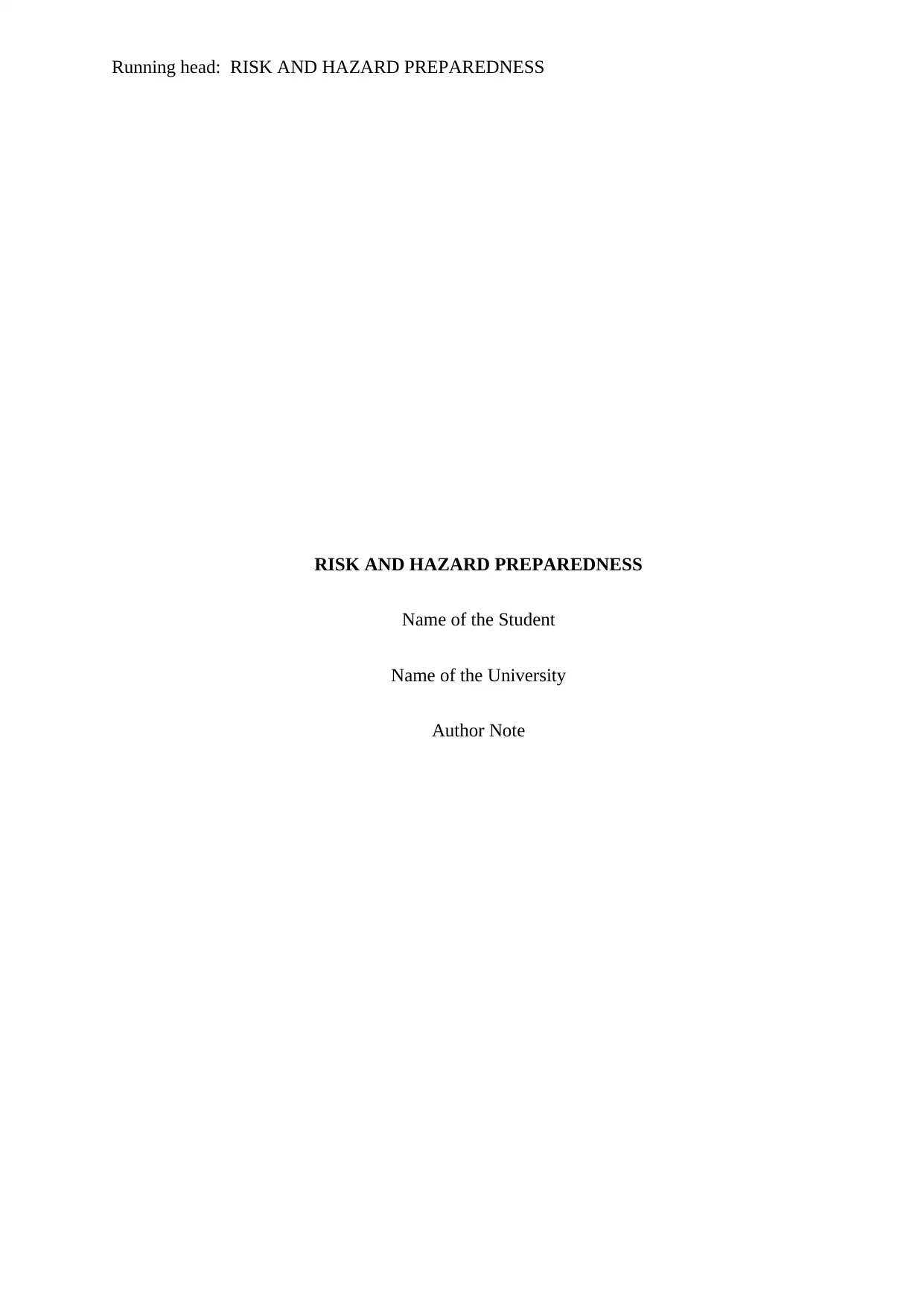
Running head: RISK AND HAZARD PREPAREDNESS
RISK AND HAZARD PREPAREDNESS
Name of the Student
Name of the University
Author Note
RISK AND HAZARD PREPAREDNESS
Name of the Student
Name of the University
Author Note
Paraphrase This Document
Need a fresh take? Get an instant paraphrase of this document with our AI Paraphraser
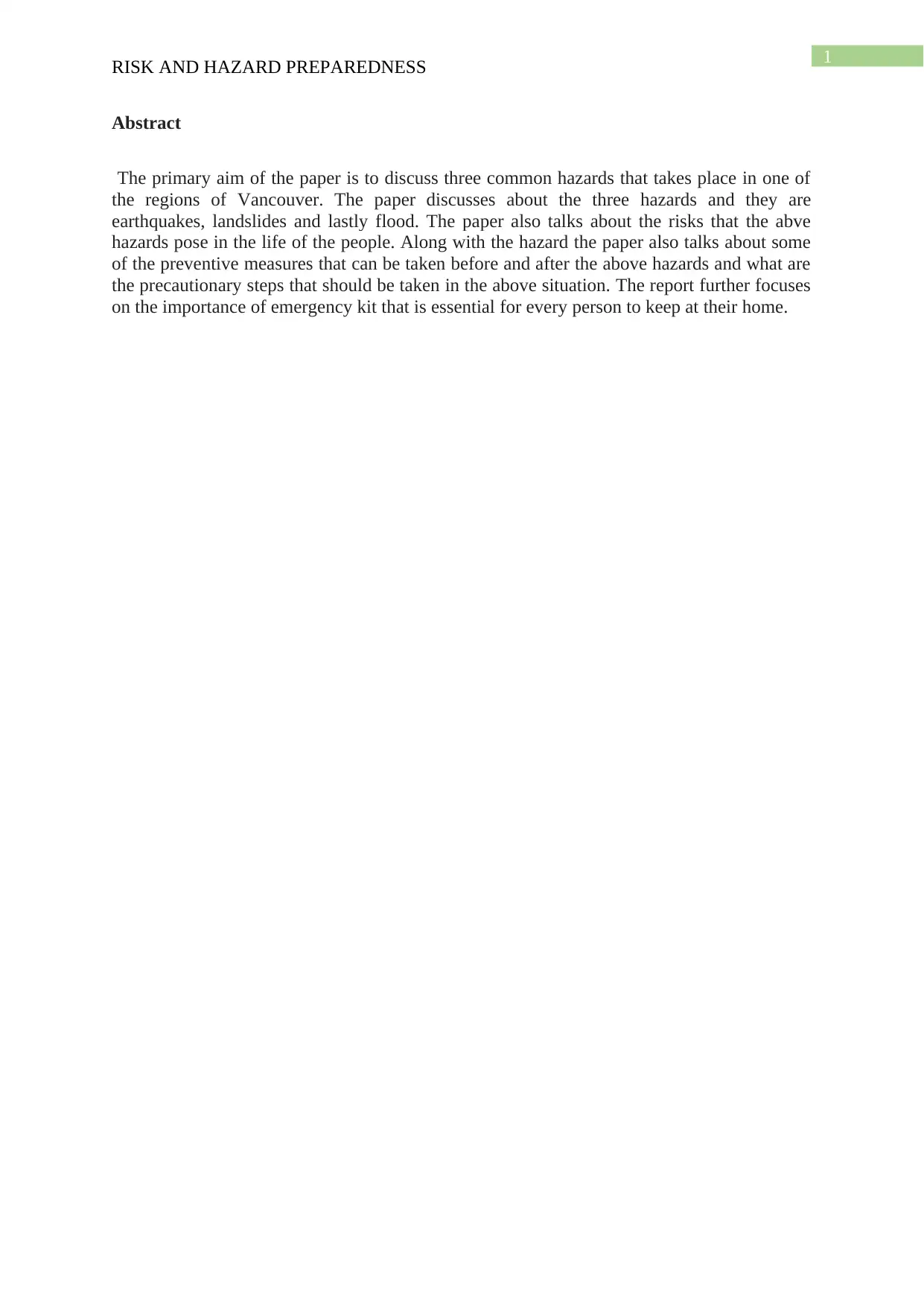
1
RISK AND HAZARD PREPAREDNESS
Abstract
The primary aim of the paper is to discuss three common hazards that takes place in one of
the regions of Vancouver. The paper discusses about the three hazards and they are
earthquakes, landslides and lastly flood. The paper also talks about the risks that the abve
hazards pose in the life of the people. Along with the hazard the paper also talks about some
of the preventive measures that can be taken before and after the above hazards and what are
the precautionary steps that should be taken in the above situation. The report further focuses
on the importance of emergency kit that is essential for every person to keep at their home.
RISK AND HAZARD PREPAREDNESS
Abstract
The primary aim of the paper is to discuss three common hazards that takes place in one of
the regions of Vancouver. The paper discusses about the three hazards and they are
earthquakes, landslides and lastly flood. The paper also talks about the risks that the abve
hazards pose in the life of the people. Along with the hazard the paper also talks about some
of the preventive measures that can be taken before and after the above hazards and what are
the precautionary steps that should be taken in the above situation. The report further focuses
on the importance of emergency kit that is essential for every person to keep at their home.
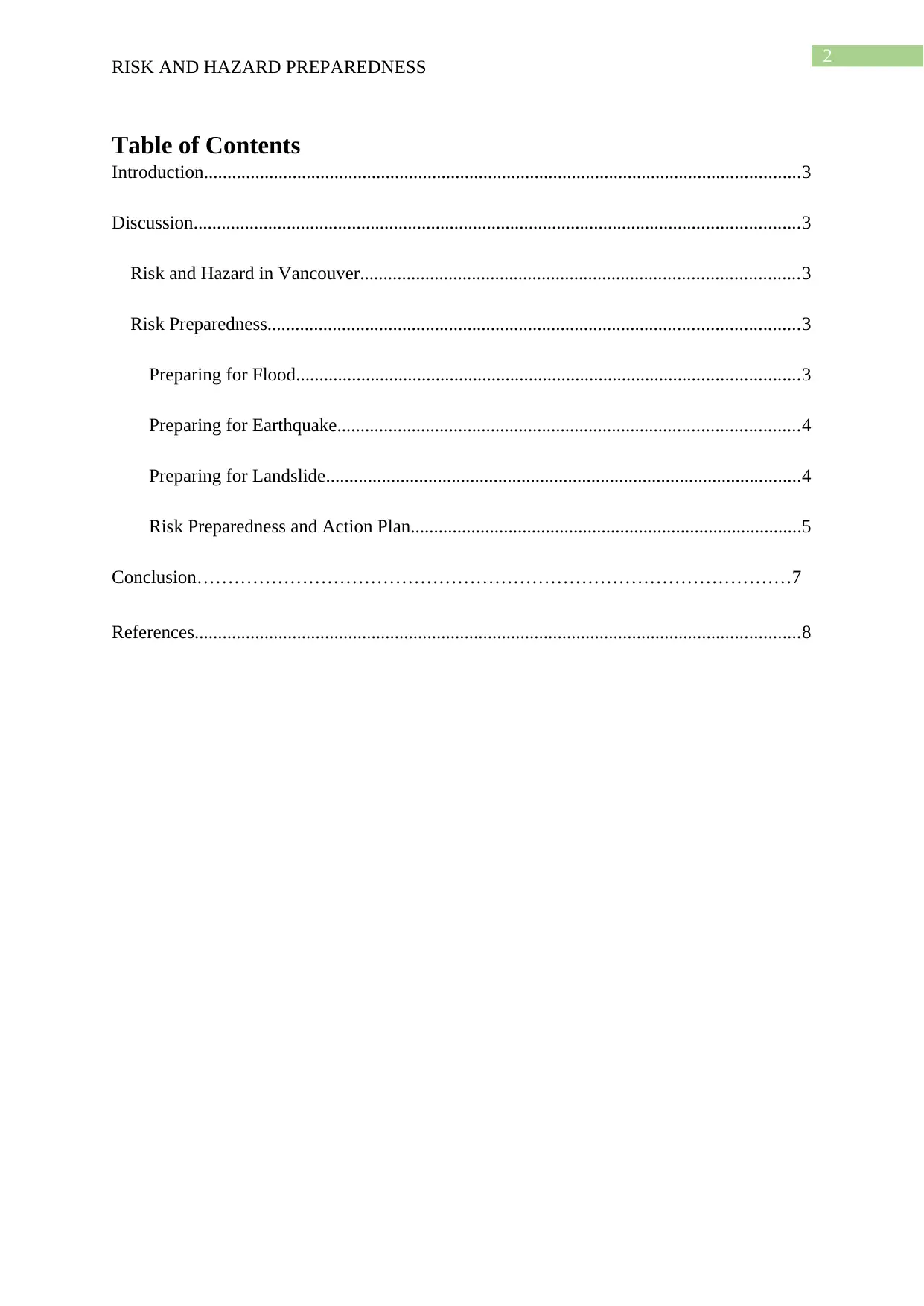
2
RISK AND HAZARD PREPAREDNESS
Table of Contents
Introduction................................................................................................................................3
Discussion..................................................................................................................................3
Risk and Hazard in Vancouver..............................................................................................3
Risk Preparedness..................................................................................................................3
Preparing for Flood............................................................................................................3
Preparing for Earthquake...................................................................................................4
Preparing for Landslide......................................................................................................4
Risk Preparedness and Action Plan....................................................................................5
Conclusion……………………………………………………………………………………7
References..................................................................................................................................8
RISK AND HAZARD PREPAREDNESS
Table of Contents
Introduction................................................................................................................................3
Discussion..................................................................................................................................3
Risk and Hazard in Vancouver..............................................................................................3
Risk Preparedness..................................................................................................................3
Preparing for Flood............................................................................................................3
Preparing for Earthquake...................................................................................................4
Preparing for Landslide......................................................................................................4
Risk Preparedness and Action Plan....................................................................................5
Conclusion……………………………………………………………………………………7
References..................................................................................................................................8
⊘ This is a preview!⊘
Do you want full access?
Subscribe today to unlock all pages.

Trusted by 1+ million students worldwide
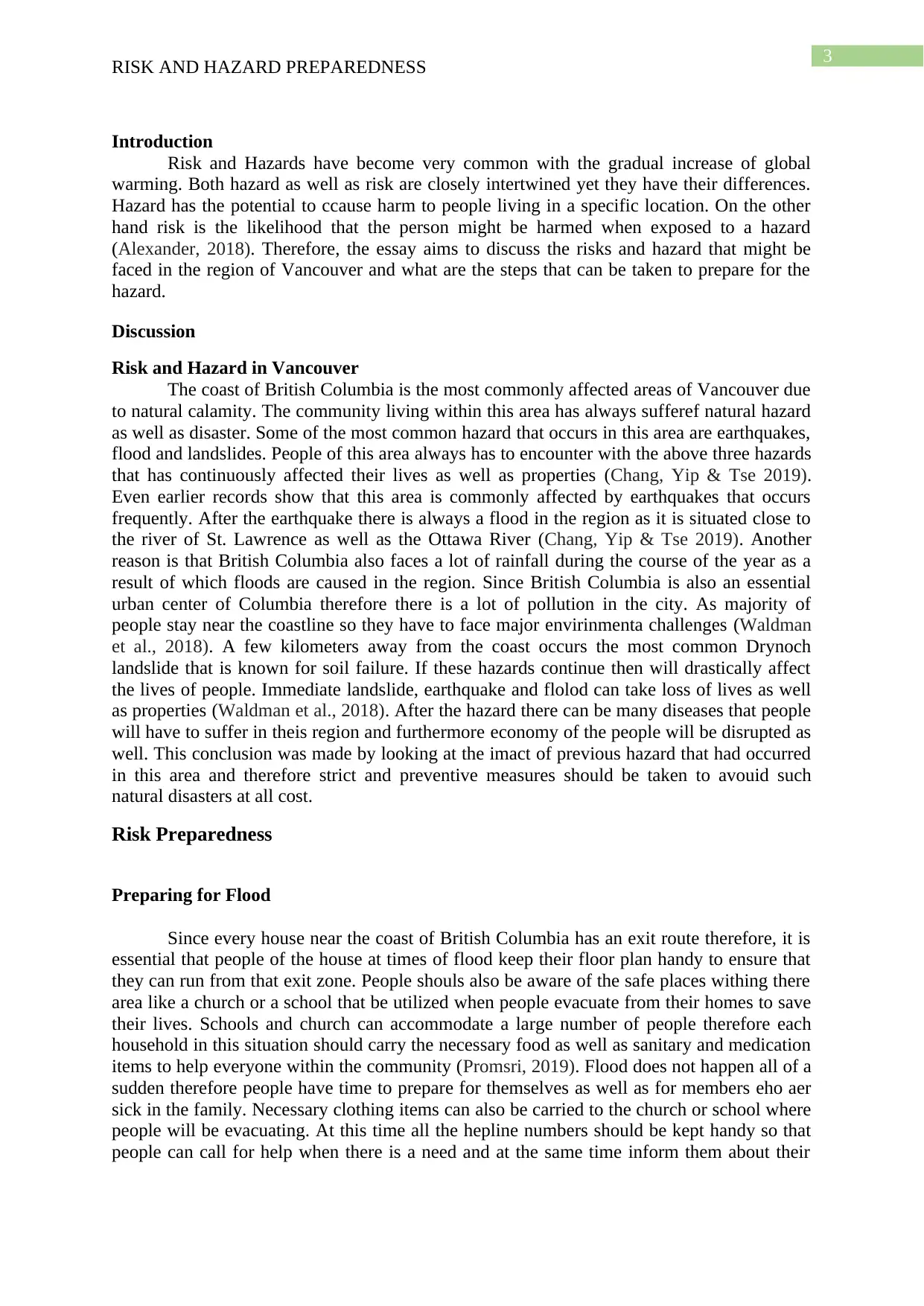
3
RISK AND HAZARD PREPAREDNESS
Introduction
Risk and Hazards have become very common with the gradual increase of global
warming. Both hazard as well as risk are closely intertwined yet they have their differences.
Hazard has the potential to ccause harm to people living in a specific location. On the other
hand risk is the likelihood that the person might be harmed when exposed to a hazard
(Alexander, 2018). Therefore, the essay aims to discuss the risks and hazard that might be
faced in the region of Vancouver and what are the steps that can be taken to prepare for the
hazard.
Discussion
Risk and Hazard in Vancouver
The coast of British Columbia is the most commonly affected areas of Vancouver due
to natural calamity. The community living within this area has always sufferef natural hazard
as well as disaster. Some of the most common hazard that occurs in this area are earthquakes,
flood and landslides. People of this area always has to encounter with the above three hazards
that has continuously affected their lives as well as properties (Chang, Yip & Tse 2019).
Even earlier records show that this area is commonly affected by earthquakes that occurs
frequently. After the earthquake there is always a flood in the region as it is situated close to
the river of St. Lawrence as well as the Ottawa River (Chang, Yip & Tse 2019). Another
reason is that British Columbia also faces a lot of rainfall during the course of the year as a
result of which floods are caused in the region. Since British Columbia is also an essential
urban center of Columbia therefore there is a lot of pollution in the city. As majority of
people stay near the coastline so they have to face major envirinmenta challenges (Waldman
et al., 2018). A few kilometers away from the coast occurs the most common Drynoch
landslide that is known for soil failure. If these hazards continue then will drastically affect
the lives of people. Immediate landslide, earthquake and flolod can take loss of lives as well
as properties (Waldman et al., 2018). After the hazard there can be many diseases that people
will have to suffer in theis region and furthermore economy of the people will be disrupted as
well. This conclusion was made by looking at the imact of previous hazard that had occurred
in this area and therefore strict and preventive measures should be taken to avouid such
natural disasters at all cost.
Risk Preparedness
Preparing for Flood
Since every house near the coast of British Columbia has an exit route therefore, it is
essential that people of the house at times of flood keep their floor plan handy to ensure that
they can run from that exit zone. People shouls also be aware of the safe places withing there
area like a church or a school that be utilized when people evacuate from their homes to save
their lives. Schools and church can accommodate a large number of people therefore each
household in this situation should carry the necessary food as well as sanitary and medication
items to help everyone within the community (Promsri, 2019). Flood does not happen all of a
sudden therefore people have time to prepare for themselves as well as for members eho aer
sick in the family. Necessary clothing items can also be carried to the church or school where
people will be evacuating. At this time all the hepline numbers should be kept handy so that
people can call for help when there is a need and at the same time inform them about their
RISK AND HAZARD PREPAREDNESS
Introduction
Risk and Hazards have become very common with the gradual increase of global
warming. Both hazard as well as risk are closely intertwined yet they have their differences.
Hazard has the potential to ccause harm to people living in a specific location. On the other
hand risk is the likelihood that the person might be harmed when exposed to a hazard
(Alexander, 2018). Therefore, the essay aims to discuss the risks and hazard that might be
faced in the region of Vancouver and what are the steps that can be taken to prepare for the
hazard.
Discussion
Risk and Hazard in Vancouver
The coast of British Columbia is the most commonly affected areas of Vancouver due
to natural calamity. The community living within this area has always sufferef natural hazard
as well as disaster. Some of the most common hazard that occurs in this area are earthquakes,
flood and landslides. People of this area always has to encounter with the above three hazards
that has continuously affected their lives as well as properties (Chang, Yip & Tse 2019).
Even earlier records show that this area is commonly affected by earthquakes that occurs
frequently. After the earthquake there is always a flood in the region as it is situated close to
the river of St. Lawrence as well as the Ottawa River (Chang, Yip & Tse 2019). Another
reason is that British Columbia also faces a lot of rainfall during the course of the year as a
result of which floods are caused in the region. Since British Columbia is also an essential
urban center of Columbia therefore there is a lot of pollution in the city. As majority of
people stay near the coastline so they have to face major envirinmenta challenges (Waldman
et al., 2018). A few kilometers away from the coast occurs the most common Drynoch
landslide that is known for soil failure. If these hazards continue then will drastically affect
the lives of people. Immediate landslide, earthquake and flolod can take loss of lives as well
as properties (Waldman et al., 2018). After the hazard there can be many diseases that people
will have to suffer in theis region and furthermore economy of the people will be disrupted as
well. This conclusion was made by looking at the imact of previous hazard that had occurred
in this area and therefore strict and preventive measures should be taken to avouid such
natural disasters at all cost.
Risk Preparedness
Preparing for Flood
Since every house near the coast of British Columbia has an exit route therefore, it is
essential that people of the house at times of flood keep their floor plan handy to ensure that
they can run from that exit zone. People shouls also be aware of the safe places withing there
area like a church or a school that be utilized when people evacuate from their homes to save
their lives. Schools and church can accommodate a large number of people therefore each
household in this situation should carry the necessary food as well as sanitary and medication
items to help everyone within the community (Promsri, 2019). Flood does not happen all of a
sudden therefore people have time to prepare for themselves as well as for members eho aer
sick in the family. Necessary clothing items can also be carried to the church or school where
people will be evacuating. At this time all the hepline numbers should be kept handy so that
people can call for help when there is a need and at the same time inform them about their
Paraphrase This Document
Need a fresh take? Get an instant paraphrase of this document with our AI Paraphraser
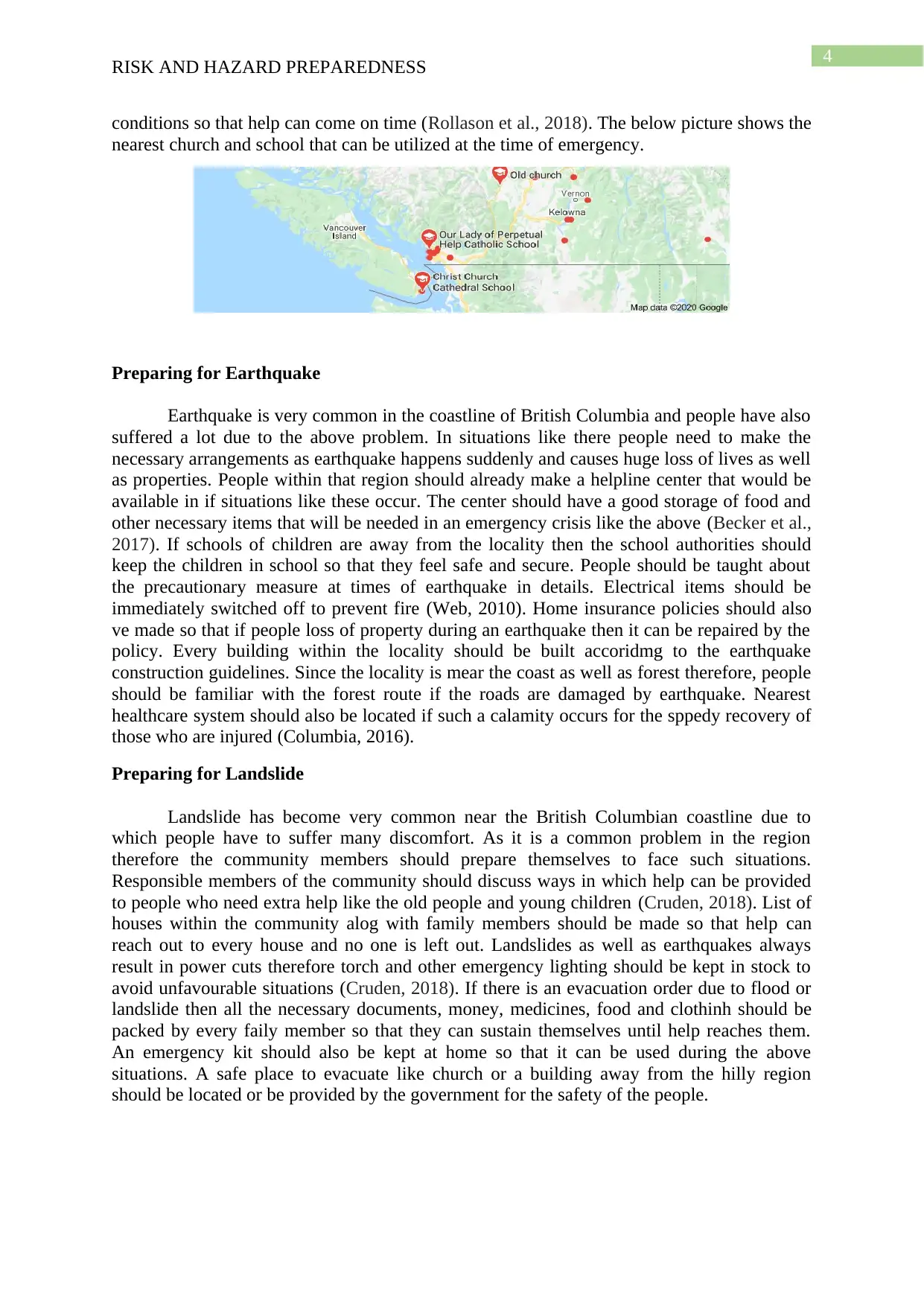
4
RISK AND HAZARD PREPAREDNESS
conditions so that help can come on time (Rollason et al., 2018). The below picture shows the
nearest church and school that can be utilized at the time of emergency.
Preparing for Earthquake
Earthquake is very common in the coastline of British Columbia and people have also
suffered a lot due to the above problem. In situations like there people need to make the
necessary arrangements as earthquake happens suddenly and causes huge loss of lives as well
as properties. People within that region should already make a helpline center that would be
available in if situations like these occur. The center should have a good storage of food and
other necessary items that will be needed in an emergency crisis like the above (Becker et al.,
2017). If schools of children are away from the locality then the school authorities should
keep the children in school so that they feel safe and secure. People should be taught about
the precautionary measure at times of earthquake in details. Electrical items should be
immediately switched off to prevent fire (Web, 2010). Home insurance policies should also
ve made so that if people loss of property during an earthquake then it can be repaired by the
policy. Every building within the locality should be built accoridmg to the earthquake
construction guidelines. Since the locality is mear the coast as well as forest therefore, people
should be familiar with the forest route if the roads are damaged by earthquake. Nearest
healthcare system should also be located if such a calamity occurs for the sppedy recovery of
those who are injured (Columbia, 2016).
Preparing for Landslide
Landslide has become very common near the British Columbian coastline due to
which people have to suffer many discomfort. As it is a common problem in the region
therefore the community members should prepare themselves to face such situations.
Responsible members of the community should discuss ways in which help can be provided
to people who need extra help like the old people and young children (Cruden, 2018). List of
houses within the community alog with family members should be made so that help can
reach out to every house and no one is left out. Landslides as well as earthquakes always
result in power cuts therefore torch and other emergency lighting should be kept in stock to
avoid unfavourable situations (Cruden, 2018). If there is an evacuation order due to flood or
landslide then all the necessary documents, money, medicines, food and clothinh should be
packed by every faily member so that they can sustain themselves until help reaches them.
An emergency kit should also be kept at home so that it can be used during the above
situations. A safe place to evacuate like church or a building away from the hilly region
should be located or be provided by the government for the safety of the people.
RISK AND HAZARD PREPAREDNESS
conditions so that help can come on time (Rollason et al., 2018). The below picture shows the
nearest church and school that can be utilized at the time of emergency.
Preparing for Earthquake
Earthquake is very common in the coastline of British Columbia and people have also
suffered a lot due to the above problem. In situations like there people need to make the
necessary arrangements as earthquake happens suddenly and causes huge loss of lives as well
as properties. People within that region should already make a helpline center that would be
available in if situations like these occur. The center should have a good storage of food and
other necessary items that will be needed in an emergency crisis like the above (Becker et al.,
2017). If schools of children are away from the locality then the school authorities should
keep the children in school so that they feel safe and secure. People should be taught about
the precautionary measure at times of earthquake in details. Electrical items should be
immediately switched off to prevent fire (Web, 2010). Home insurance policies should also
ve made so that if people loss of property during an earthquake then it can be repaired by the
policy. Every building within the locality should be built accoridmg to the earthquake
construction guidelines. Since the locality is mear the coast as well as forest therefore, people
should be familiar with the forest route if the roads are damaged by earthquake. Nearest
healthcare system should also be located if such a calamity occurs for the sppedy recovery of
those who are injured (Columbia, 2016).
Preparing for Landslide
Landslide has become very common near the British Columbian coastline due to
which people have to suffer many discomfort. As it is a common problem in the region
therefore the community members should prepare themselves to face such situations.
Responsible members of the community should discuss ways in which help can be provided
to people who need extra help like the old people and young children (Cruden, 2018). List of
houses within the community alog with family members should be made so that help can
reach out to every house and no one is left out. Landslides as well as earthquakes always
result in power cuts therefore torch and other emergency lighting should be kept in stock to
avoid unfavourable situations (Cruden, 2018). If there is an evacuation order due to flood or
landslide then all the necessary documents, money, medicines, food and clothinh should be
packed by every faily member so that they can sustain themselves until help reaches them.
An emergency kit should also be kept at home so that it can be used during the above
situations. A safe place to evacuate like church or a building away from the hilly region
should be located or be provided by the government for the safety of the people.
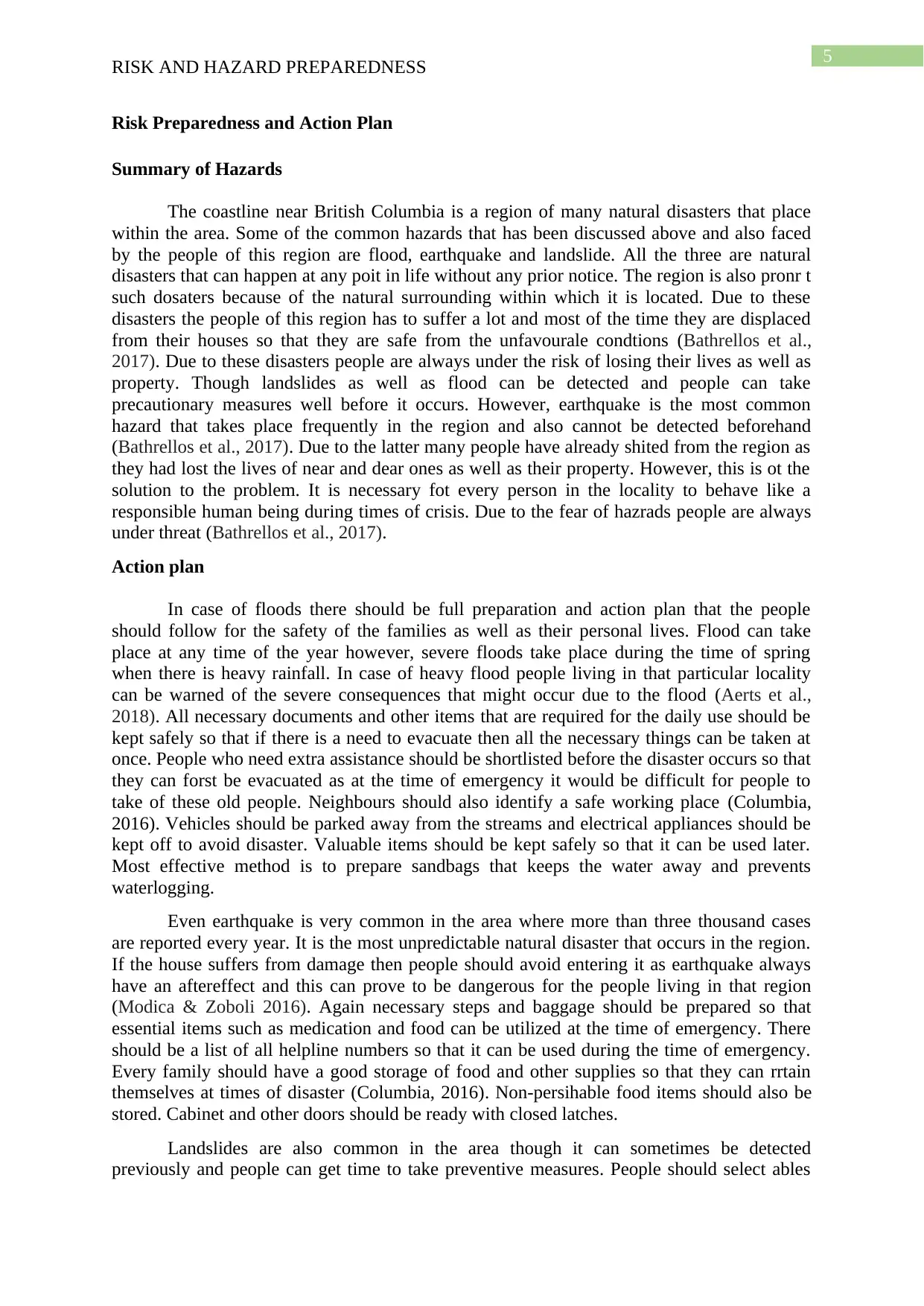
5
RISK AND HAZARD PREPAREDNESS
Risk Preparedness and Action Plan
Summary of Hazards
The coastline near British Columbia is a region of many natural disasters that place
within the area. Some of the common hazards that has been discussed above and also faced
by the people of this region are flood, earthquake and landslide. All the three are natural
disasters that can happen at any poit in life without any prior notice. The region is also pronr t
such dosaters because of the natural surrounding within which it is located. Due to these
disasters the people of this region has to suffer a lot and most of the time they are displaced
from their houses so that they are safe from the unfavourale condtions (Bathrellos et al.,
2017). Due to these disasters people are always under the risk of losing their lives as well as
property. Though landslides as well as flood can be detected and people can take
precautionary measures well before it occurs. However, earthquake is the most common
hazard that takes place frequently in the region and also cannot be detected beforehand
(Bathrellos et al., 2017). Due to the latter many people have already shited from the region as
they had lost the lives of near and dear ones as well as their property. However, this is ot the
solution to the problem. It is necessary fot every person in the locality to behave like a
responsible human being during times of crisis. Due to the fear of hazrads people are always
under threat (Bathrellos et al., 2017).
Action plan
In case of floods there should be full preparation and action plan that the people
should follow for the safety of the families as well as their personal lives. Flood can take
place at any time of the year however, severe floods take place during the time of spring
when there is heavy rainfall. In case of heavy flood people living in that particular locality
can be warned of the severe consequences that might occur due to the flood (Aerts et al.,
2018). All necessary documents and other items that are required for the daily use should be
kept safely so that if there is a need to evacuate then all the necessary things can be taken at
once. People who need extra assistance should be shortlisted before the disaster occurs so that
they can forst be evacuated as at the time of emergency it would be difficult for people to
take of these old people. Neighbours should also identify a safe working place (Columbia,
2016). Vehicles should be parked away from the streams and electrical appliances should be
kept off to avoid disaster. Valuable items should be kept safely so that it can be used later.
Most effective method is to prepare sandbags that keeps the water away and prevents
waterlogging.
Even earthquake is very common in the area where more than three thousand cases
are reported every year. It is the most unpredictable natural disaster that occurs in the region.
If the house suffers from damage then people should avoid entering it as earthquake always
have an aftereffect and this can prove to be dangerous for the people living in that region
(Modica & Zoboli 2016). Again necessary steps and baggage should be prepared so that
essential items such as medication and food can be utilized at the time of emergency. There
should be a list of all helpline numbers so that it can be used during the time of emergency.
Every family should have a good storage of food and other supplies so that they can rrtain
themselves at times of disaster (Columbia, 2016). Non-persihable food items should also be
stored. Cabinet and other doors should be ready with closed latches.
Landslides are also common in the area though it can sometimes be detected
previously and people can get time to take preventive measures. People should select ables
RISK AND HAZARD PREPAREDNESS
Risk Preparedness and Action Plan
Summary of Hazards
The coastline near British Columbia is a region of many natural disasters that place
within the area. Some of the common hazards that has been discussed above and also faced
by the people of this region are flood, earthquake and landslide. All the three are natural
disasters that can happen at any poit in life without any prior notice. The region is also pronr t
such dosaters because of the natural surrounding within which it is located. Due to these
disasters the people of this region has to suffer a lot and most of the time they are displaced
from their houses so that they are safe from the unfavourale condtions (Bathrellos et al.,
2017). Due to these disasters people are always under the risk of losing their lives as well as
property. Though landslides as well as flood can be detected and people can take
precautionary measures well before it occurs. However, earthquake is the most common
hazard that takes place frequently in the region and also cannot be detected beforehand
(Bathrellos et al., 2017). Due to the latter many people have already shited from the region as
they had lost the lives of near and dear ones as well as their property. However, this is ot the
solution to the problem. It is necessary fot every person in the locality to behave like a
responsible human being during times of crisis. Due to the fear of hazrads people are always
under threat (Bathrellos et al., 2017).
Action plan
In case of floods there should be full preparation and action plan that the people
should follow for the safety of the families as well as their personal lives. Flood can take
place at any time of the year however, severe floods take place during the time of spring
when there is heavy rainfall. In case of heavy flood people living in that particular locality
can be warned of the severe consequences that might occur due to the flood (Aerts et al.,
2018). All necessary documents and other items that are required for the daily use should be
kept safely so that if there is a need to evacuate then all the necessary things can be taken at
once. People who need extra assistance should be shortlisted before the disaster occurs so that
they can forst be evacuated as at the time of emergency it would be difficult for people to
take of these old people. Neighbours should also identify a safe working place (Columbia,
2016). Vehicles should be parked away from the streams and electrical appliances should be
kept off to avoid disaster. Valuable items should be kept safely so that it can be used later.
Most effective method is to prepare sandbags that keeps the water away and prevents
waterlogging.
Even earthquake is very common in the area where more than three thousand cases
are reported every year. It is the most unpredictable natural disaster that occurs in the region.
If the house suffers from damage then people should avoid entering it as earthquake always
have an aftereffect and this can prove to be dangerous for the people living in that region
(Modica & Zoboli 2016). Again necessary steps and baggage should be prepared so that
essential items such as medication and food can be utilized at the time of emergency. There
should be a list of all helpline numbers so that it can be used during the time of emergency.
Every family should have a good storage of food and other supplies so that they can rrtain
themselves at times of disaster (Columbia, 2016). Non-persihable food items should also be
stored. Cabinet and other doors should be ready with closed latches.
Landslides are also common in the area though it can sometimes be detected
previously and people can get time to take preventive measures. People should select ables
⊘ This is a preview!⊘
Do you want full access?
Subscribe today to unlock all pages.

Trusted by 1+ million students worldwide
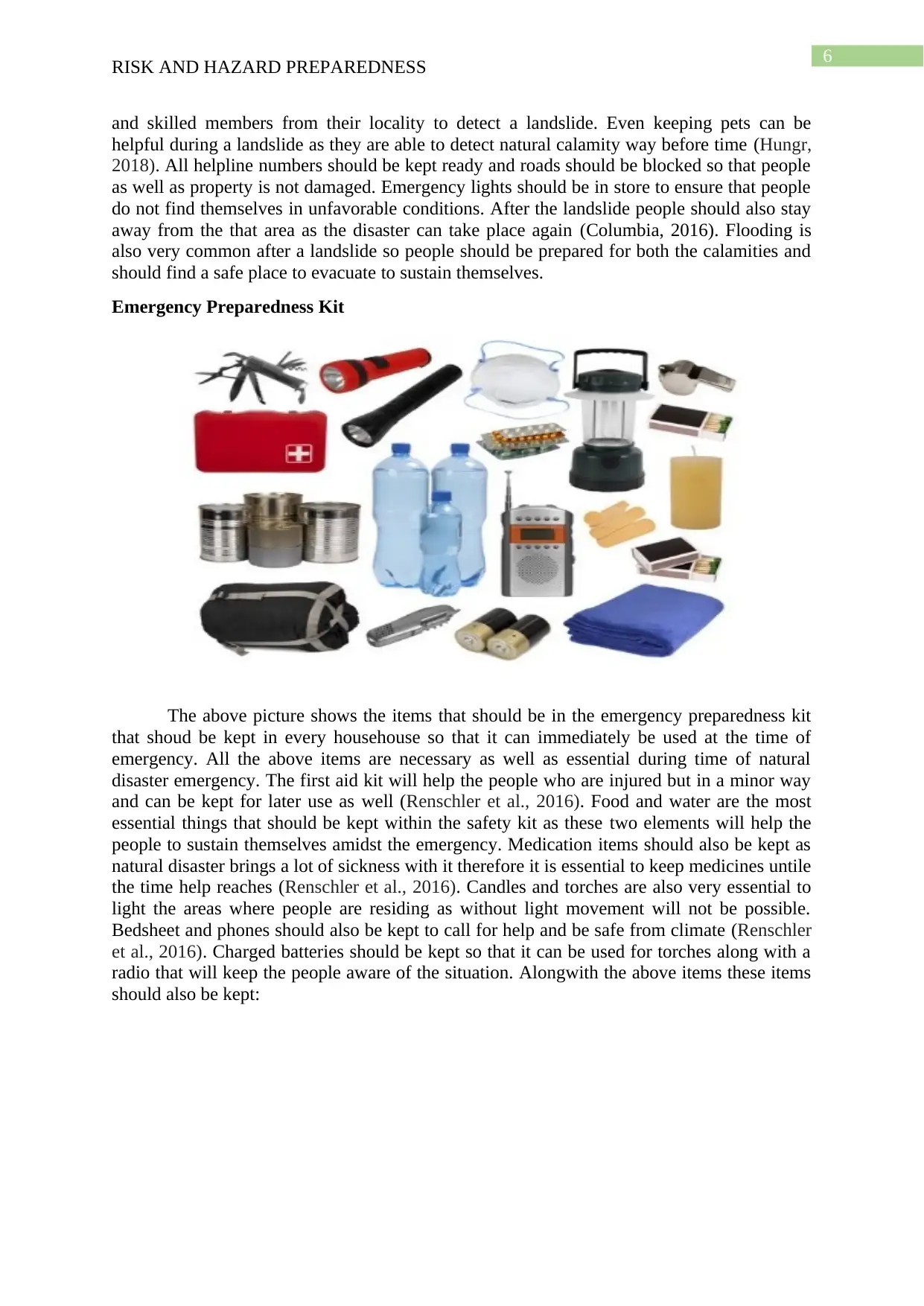
6
RISK AND HAZARD PREPAREDNESS
and skilled members from their locality to detect a landslide. Even keeping pets can be
helpful during a landslide as they are able to detect natural calamity way before time (Hungr,
2018). All helpline numbers should be kept ready and roads should be blocked so that people
as well as property is not damaged. Emergency lights should be in store to ensure that people
do not find themselves in unfavorable conditions. After the landslide people should also stay
away from the that area as the disaster can take place again (Columbia, 2016). Flooding is
also very common after a landslide so people should be prepared for both the calamities and
should find a safe place to evacuate to sustain themselves.
Emergency Preparedness Kit
The above picture shows the items that should be in the emergency preparedness kit
that shoud be kept in every househouse so that it can immediately be used at the time of
emergency. All the above items are necessary as well as essential during time of natural
disaster emergency. The first aid kit will help the people who are injured but in a minor way
and can be kept for later use as well (Renschler et al., 2016). Food and water are the most
essential things that should be kept within the safety kit as these two elements will help the
people to sustain themselves amidst the emergency. Medication items should also be kept as
natural disaster brings a lot of sickness with it therefore it is essential to keep medicines untile
the time help reaches (Renschler et al., 2016). Candles and torches are also very essential to
light the areas where people are residing as without light movement will not be possible.
Bedsheet and phones should also be kept to call for help and be safe from climate (Renschler
et al., 2016). Charged batteries should be kept so that it can be used for torches along with a
radio that will keep the people aware of the situation. Alongwith the above items these items
should also be kept:
RISK AND HAZARD PREPAREDNESS
and skilled members from their locality to detect a landslide. Even keeping pets can be
helpful during a landslide as they are able to detect natural calamity way before time (Hungr,
2018). All helpline numbers should be kept ready and roads should be blocked so that people
as well as property is not damaged. Emergency lights should be in store to ensure that people
do not find themselves in unfavorable conditions. After the landslide people should also stay
away from the that area as the disaster can take place again (Columbia, 2016). Flooding is
also very common after a landslide so people should be prepared for both the calamities and
should find a safe place to evacuate to sustain themselves.
Emergency Preparedness Kit
The above picture shows the items that should be in the emergency preparedness kit
that shoud be kept in every househouse so that it can immediately be used at the time of
emergency. All the above items are necessary as well as essential during time of natural
disaster emergency. The first aid kit will help the people who are injured but in a minor way
and can be kept for later use as well (Renschler et al., 2016). Food and water are the most
essential things that should be kept within the safety kit as these two elements will help the
people to sustain themselves amidst the emergency. Medication items should also be kept as
natural disaster brings a lot of sickness with it therefore it is essential to keep medicines untile
the time help reaches (Renschler et al., 2016). Candles and torches are also very essential to
light the areas where people are residing as without light movement will not be possible.
Bedsheet and phones should also be kept to call for help and be safe from climate (Renschler
et al., 2016). Charged batteries should be kept so that it can be used for torches along with a
radio that will keep the people aware of the situation. Alongwith the above items these items
should also be kept:
Paraphrase This Document
Need a fresh take? Get an instant paraphrase of this document with our AI Paraphraser
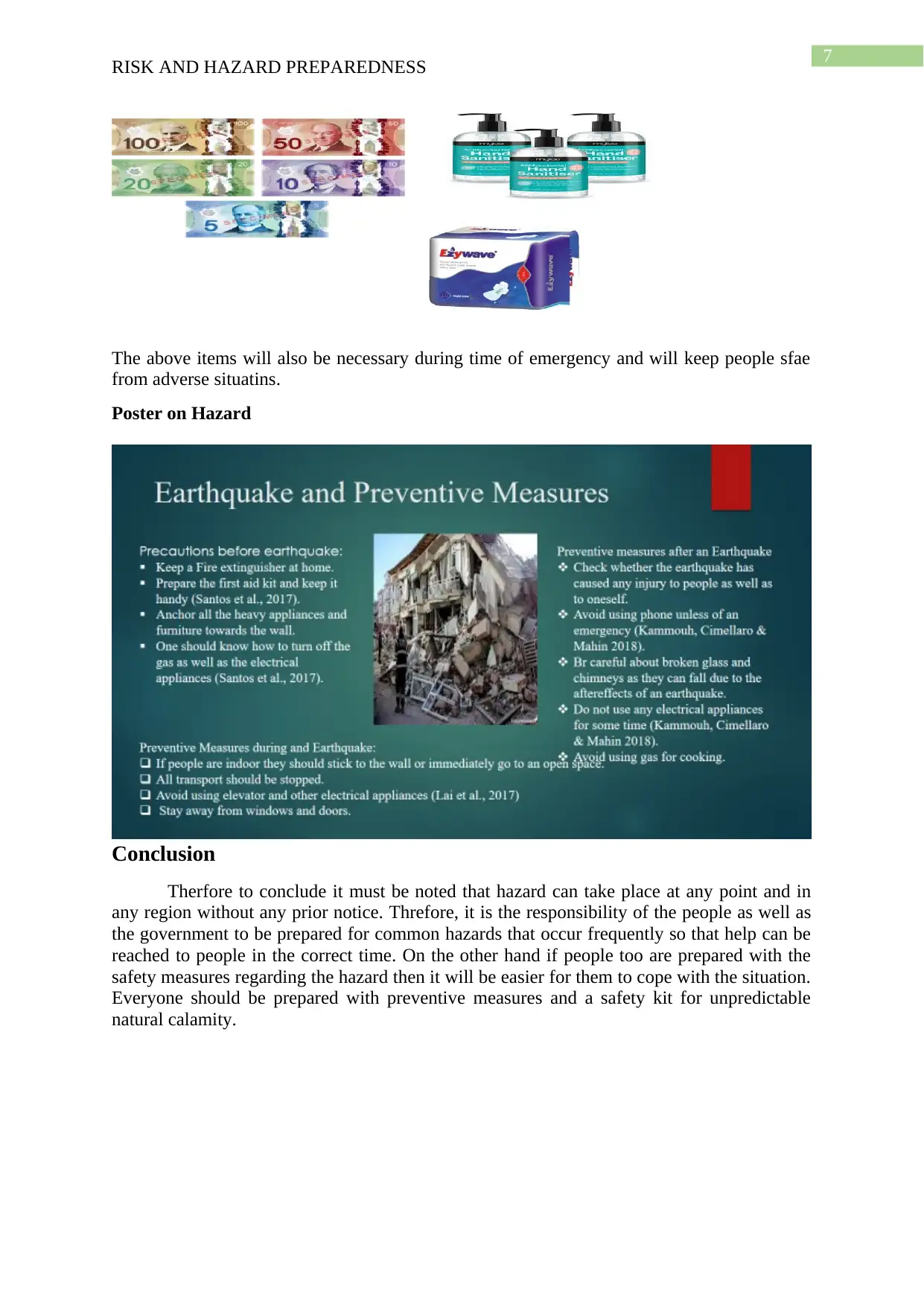
7
RISK AND HAZARD PREPAREDNESS
The above items will also be necessary during time of emergency and will keep people sfae
from adverse situatins.
Poster on Hazard
Conclusion
Therfore to conclude it must be noted that hazard can take place at any point and in
any region without any prior notice. Threfore, it is the responsibility of the people as well as
the government to be prepared for common hazards that occur frequently so that help can be
reached to people in the correct time. On the other hand if people too are prepared with the
safety measures regarding the hazard then it will be easier for them to cope with the situation.
Everyone should be prepared with preventive measures and a safety kit for unpredictable
natural calamity.
RISK AND HAZARD PREPAREDNESS
The above items will also be necessary during time of emergency and will keep people sfae
from adverse situatins.
Poster on Hazard
Conclusion
Therfore to conclude it must be noted that hazard can take place at any point and in
any region without any prior notice. Threfore, it is the responsibility of the people as well as
the government to be prepared for common hazards that occur frequently so that help can be
reached to people in the correct time. On the other hand if people too are prepared with the
safety measures regarding the hazard then it will be easier for them to cope with the situation.
Everyone should be prepared with preventive measures and a safety kit for unpredictable
natural calamity.
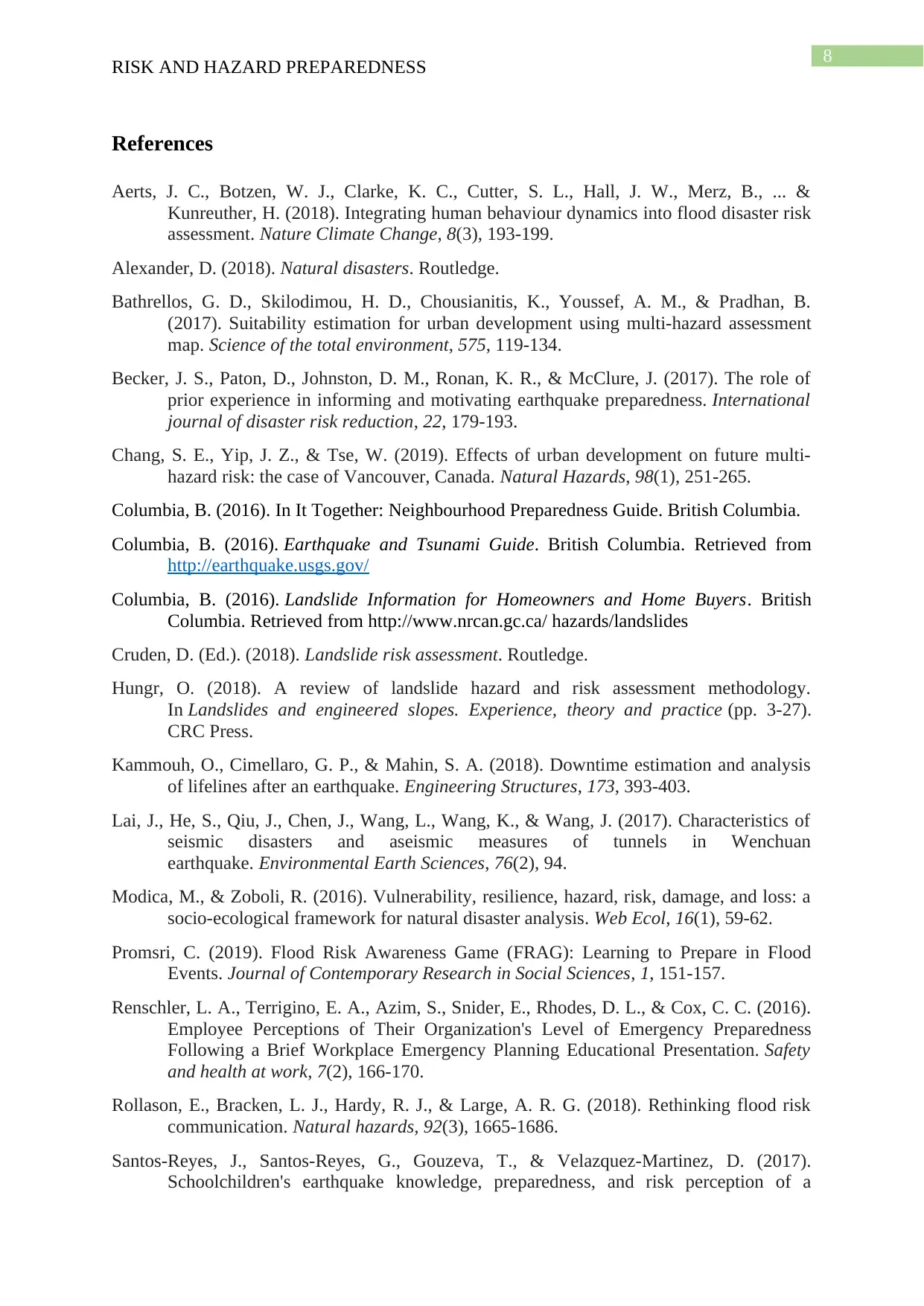
8
RISK AND HAZARD PREPAREDNESS
References
Aerts, J. C., Botzen, W. J., Clarke, K. C., Cutter, S. L., Hall, J. W., Merz, B., ... &
Kunreuther, H. (2018). Integrating human behaviour dynamics into flood disaster risk
assessment. Nature Climate Change, 8(3), 193-199.
Alexander, D. (2018). Natural disasters. Routledge.
Bathrellos, G. D., Skilodimou, H. D., Chousianitis, K., Youssef, A. M., & Pradhan, B.
(2017). Suitability estimation for urban development using multi-hazard assessment
map. Science of the total environment, 575, 119-134.
Becker, J. S., Paton, D., Johnston, D. M., Ronan, K. R., & McClure, J. (2017). The role of
prior experience in informing and motivating earthquake preparedness. International
journal of disaster risk reduction, 22, 179-193.
Chang, S. E., Yip, J. Z., & Tse, W. (2019). Effects of urban development on future multi-
hazard risk: the case of Vancouver, Canada. Natural Hazards, 98(1), 251-265.
Columbia, B. (2016). In It Together: Neighbourhood Preparedness Guide. British Columbia.
Columbia, B. (2016). Earthquake and Tsunami Guide. British Columbia. Retrieved from
http://earthquake.usgs.gov/
Columbia, B. (2016). Landslide Information for Homeowners and Home Buyers. British
Columbia. Retrieved from http://www.nrcan.gc.ca/ hazards/landslides
Cruden, D. (Ed.). (2018). Landslide risk assessment. Routledge.
Hungr, O. (2018). A review of landslide hazard and risk assessment methodology.
In Landslides and engineered slopes. Experience, theory and practice (pp. 3-27).
CRC Press.
Kammouh, O., Cimellaro, G. P., & Mahin, S. A. (2018). Downtime estimation and analysis
of lifelines after an earthquake. Engineering Structures, 173, 393-403.
Lai, J., He, S., Qiu, J., Chen, J., Wang, L., Wang, K., & Wang, J. (2017). Characteristics of
seismic disasters and aseismic measures of tunnels in Wenchuan
earthquake. Environmental Earth Sciences, 76(2), 94.
Modica, M., & Zoboli, R. (2016). Vulnerability, resilience, hazard, risk, damage, and loss: a
socio-ecological framework for natural disaster analysis. Web Ecol, 16(1), 59-62.
Promsri, C. (2019). Flood Risk Awareness Game (FRAG): Learning to Prepare in Flood
Events. Journal of Contemporary Research in Social Sciences, 1, 151-157.
Renschler, L. A., Terrigino, E. A., Azim, S., Snider, E., Rhodes, D. L., & Cox, C. C. (2016).
Employee Perceptions of Their Organization's Level of Emergency Preparedness
Following a Brief Workplace Emergency Planning Educational Presentation. Safety
and health at work, 7(2), 166-170.
Rollason, E., Bracken, L. J., Hardy, R. J., & Large, A. R. G. (2018). Rethinking flood risk
communication. Natural hazards, 92(3), 1665-1686.
Santos-Reyes, J., Santos-Reyes, G., Gouzeva, T., & Velazquez-Martinez, D. (2017).
Schoolchildren's earthquake knowledge, preparedness, and risk perception of a
RISK AND HAZARD PREPAREDNESS
References
Aerts, J. C., Botzen, W. J., Clarke, K. C., Cutter, S. L., Hall, J. W., Merz, B., ... &
Kunreuther, H. (2018). Integrating human behaviour dynamics into flood disaster risk
assessment. Nature Climate Change, 8(3), 193-199.
Alexander, D. (2018). Natural disasters. Routledge.
Bathrellos, G. D., Skilodimou, H. D., Chousianitis, K., Youssef, A. M., & Pradhan, B.
(2017). Suitability estimation for urban development using multi-hazard assessment
map. Science of the total environment, 575, 119-134.
Becker, J. S., Paton, D., Johnston, D. M., Ronan, K. R., & McClure, J. (2017). The role of
prior experience in informing and motivating earthquake preparedness. International
journal of disaster risk reduction, 22, 179-193.
Chang, S. E., Yip, J. Z., & Tse, W. (2019). Effects of urban development on future multi-
hazard risk: the case of Vancouver, Canada. Natural Hazards, 98(1), 251-265.
Columbia, B. (2016). In It Together: Neighbourhood Preparedness Guide. British Columbia.
Columbia, B. (2016). Earthquake and Tsunami Guide. British Columbia. Retrieved from
http://earthquake.usgs.gov/
Columbia, B. (2016). Landslide Information for Homeowners and Home Buyers. British
Columbia. Retrieved from http://www.nrcan.gc.ca/ hazards/landslides
Cruden, D. (Ed.). (2018). Landslide risk assessment. Routledge.
Hungr, O. (2018). A review of landslide hazard and risk assessment methodology.
In Landslides and engineered slopes. Experience, theory and practice (pp. 3-27).
CRC Press.
Kammouh, O., Cimellaro, G. P., & Mahin, S. A. (2018). Downtime estimation and analysis
of lifelines after an earthquake. Engineering Structures, 173, 393-403.
Lai, J., He, S., Qiu, J., Chen, J., Wang, L., Wang, K., & Wang, J. (2017). Characteristics of
seismic disasters and aseismic measures of tunnels in Wenchuan
earthquake. Environmental Earth Sciences, 76(2), 94.
Modica, M., & Zoboli, R. (2016). Vulnerability, resilience, hazard, risk, damage, and loss: a
socio-ecological framework for natural disaster analysis. Web Ecol, 16(1), 59-62.
Promsri, C. (2019). Flood Risk Awareness Game (FRAG): Learning to Prepare in Flood
Events. Journal of Contemporary Research in Social Sciences, 1, 151-157.
Renschler, L. A., Terrigino, E. A., Azim, S., Snider, E., Rhodes, D. L., & Cox, C. C. (2016).
Employee Perceptions of Their Organization's Level of Emergency Preparedness
Following a Brief Workplace Emergency Planning Educational Presentation. Safety
and health at work, 7(2), 166-170.
Rollason, E., Bracken, L. J., Hardy, R. J., & Large, A. R. G. (2018). Rethinking flood risk
communication. Natural hazards, 92(3), 1665-1686.
Santos-Reyes, J., Santos-Reyes, G., Gouzeva, T., & Velazquez-Martinez, D. (2017).
Schoolchildren's earthquake knowledge, preparedness, and risk perception of a
⊘ This is a preview!⊘
Do you want full access?
Subscribe today to unlock all pages.

Trusted by 1+ million students worldwide
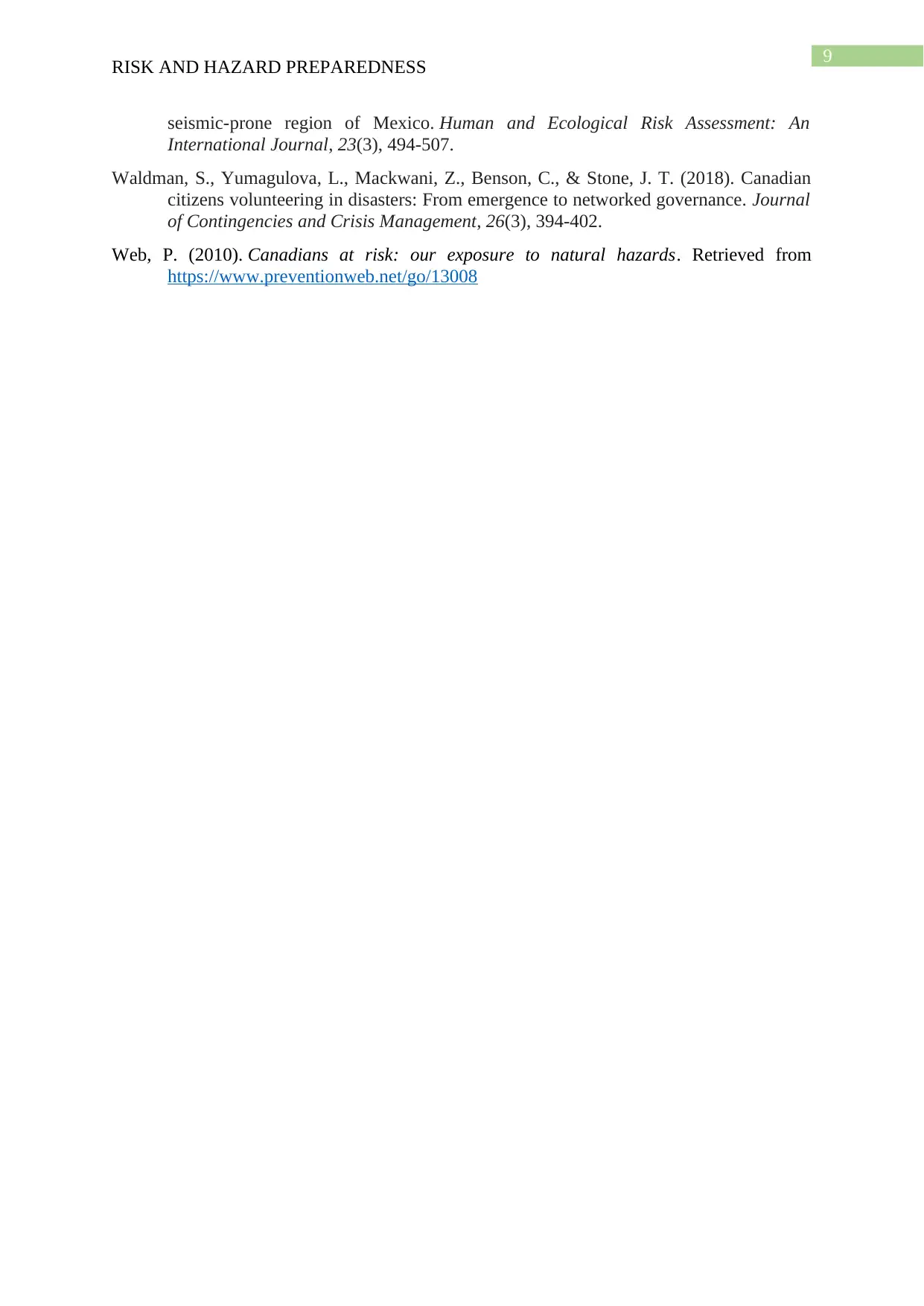
9
RISK AND HAZARD PREPAREDNESS
seismic-prone region of Mexico. Human and Ecological Risk Assessment: An
International Journal, 23(3), 494-507.
Waldman, S., Yumagulova, L., Mackwani, Z., Benson, C., & Stone, J. T. (2018). Canadian
citizens volunteering in disasters: From emergence to networked governance. Journal
of Contingencies and Crisis Management, 26(3), 394-402.
Web, P. (2010). Canadians at risk: our exposure to natural hazards. Retrieved from
https://www.preventionweb.net/go/13008
RISK AND HAZARD PREPAREDNESS
seismic-prone region of Mexico. Human and Ecological Risk Assessment: An
International Journal, 23(3), 494-507.
Waldman, S., Yumagulova, L., Mackwani, Z., Benson, C., & Stone, J. T. (2018). Canadian
citizens volunteering in disasters: From emergence to networked governance. Journal
of Contingencies and Crisis Management, 26(3), 394-402.
Web, P. (2010). Canadians at risk: our exposure to natural hazards. Retrieved from
https://www.preventionweb.net/go/13008
1 out of 10
Your All-in-One AI-Powered Toolkit for Academic Success.
+13062052269
info@desklib.com
Available 24*7 on WhatsApp / Email
![[object Object]](/_next/static/media/star-bottom.7253800d.svg)
Unlock your academic potential
Copyright © 2020–2025 A2Z Services. All Rights Reserved. Developed and managed by ZUCOL.

